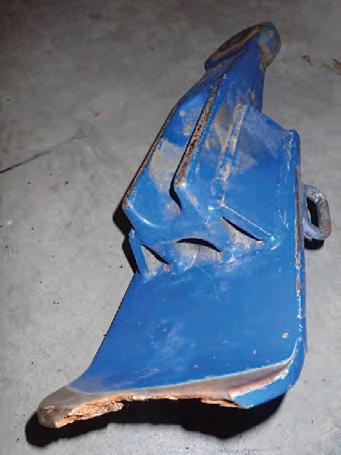
7 minute read
Australian Road Transport Suppliers’ Association
Strength of drawbars and towbars
This article is about the strength requirements of drawbars that connect an ‘A-type’ trailer to a towing vehicle, and towbars that connect the towing vehicle onto the tow coupling of the trailer. I have investigated several drawbar failures and I am concerned about the strength of some of the drawbars that I see on some trailers. Drawbars will be found on dog trailers, dolly trailers, and centre-axle (pig) trailers. Towbars can be found on the rear of rigid trucks and on multicombination trailers. Drawbars and towbars are of high safety importance because the partial failure of either could allow the trailer to sway out-oflane; or a complete failure will allow the trailer to come free. Drawbars and towbars are regulated components for new trailers. Sections 14 and 13 respectively of ADR 62/02 Mechanical Couplings are applicable. The strength requirements for drawbars from ADR 62/02 S14 are shown in the diagram. It has been assumed that the aggregrate trailer mass (ATM) is
Strength limits in ADR 62/02
Transverse Strength 120 kN Alternatively, lesser values for dog and pig trailers based upon axle ratings and dimensions.
Longitudinal strength ATM < 23.5t 1.5 x ATM ATM > 23.5t 350kN or 2.25 x D-value requirement.
Vertical Strength 120 kN or: Fixed: 2.25 x V-value Hinged: 10kN
2θ
greater than 23.5t. The coupling type on the end of the drawbar (cylindrical eye, toroidal eye or Bartlett ball head) comes into the drawbar strength requirements via the alternative D-value based formula in Longitudinal strength. The D-value formula is equivalent to 350 kN (~ 35t pull) strength requirement with a D-value of 155kN, which is a modest value. The drawbar was probably designed for a range of couplings, so it is sensible to assume the required strength is 350 kN to cover all possible coupling D-values. Whilst the strength of the coupling is separately regulated, the strength of a mounting block for a demountable towing eye, including its welding or bolt attachment, is part of the drawbar strength. Drawbar strength can be proven by strength tests or by ‘approved calculations’ which means approved computer-based stress analysis. Welds are usually modelled as continuous metal. The mounting block is usually ignored when strength is calculated. When strength is proven by tests, the
*The alternative arrangements depend upon the drawbar length and the trailer mass rating.
Note that kN converts to tonnes-force by dividing by 9.806 which is about 10. So 350 KN strength is ~ 35 tonne-force pull.
Example for a 4-axle dog trailer with ATM = 34t & a hinged drawbar.
Vertical Strength with hinges locked 10 kN (~1t)
Transverse Strength 76 kN (~7.6t)
drawbar and its components must not deform or have breaks, cracks or separations after each of the test forces is applied separately. Rigid drawbars (usually on centre-axle trailers) can be cycle tested (endurance or fatigue testing), but this is complicated and rarely done in Australia. The drawbar must be securely attached to a substantial structural member on the trailer. For a hinged drawbar, this will be via cylindrical hinge pins on the front transverse beam of the trailer. For a rigid drawbar the attachment is preferably by integrating the drawbar beams into the trailer subframe design. Care must be taken with the fixed drawbar to ensure that there is a gradual change of strength, usually by gusseting, where the drawbar emerges from the subframe. Otherwise fatigue cracking can be expected to occur at this location. The following Table gives the ADR 62/02 strength requirements for a 4-axle dog trailer with ATM = 34t, four axles each rated at 10t, a front tandem group rating of 20t, D-Value of 133 kN and a drawbar length of 6m. It is notable that these strength requirements take no account of the towing load on the rear of the trailer; only the trailer ATM need be considered in determining the strength requirements. If the drawbar is on the first dolly trailer of an AB-double roadtrain, it is plausible that it is pulling a 60t load. The pulling forces that might occur on the road are
assumed to be the D-value and V-value
requirements that apply at the drawbar
or towbar. Considering the longitudinal stresses in the beams, basic static analysis shows that the stress in each beam assuming a test load of 350 kN, is 350kN / (2AC θsθ), where A is the cross-sectional area of the metal in the beam. If the drawbar beam is 90mm x 90mm x 6 mm (rectangular section) and 250 grade material, the cross-sectional area A = 20.2 cm 2 . If the
LONGITUDINAL STRENGTH REQUIREMENT
350 kN (~ 35t) default 2.25x D-value = 300 kN (~30t) TRANSVERSE STRENGTH REQUIREMENT
120 kN (~ 12t) or 18 x 20/(6-1) = 76kN (~ 7.6t) VERTICAL STRENGTH REQUIREMENT
10kN (~ 1t) D-, V- AND S-VALUES
D = 133 kN S = 10 kN V = N/A
Photo 1: This failure probably originated in a poor quality weld.

drawbar length is 6m and the distance between the drawbar hinges is 1m, then θ = 4.8°. The beam stress is ~ 87 megapascals (MPa), which is about 35 per cent of the yield strength. That is, there is a factor of safety of about three for longitudinal strength. Drawbars and towbars should have a factor of safety of at least three for all strength requirements to provide protection against in-service fatigue cracking. The drawbar failures that I have seen have failed either because there is too greater change in strength between the coupling plate and the beams, or welding deficiencies. The change in strength of the drawbar should be graduated by long gussets between the coupling mounting plate and the longitudinal beams. Stress concentrations occur where there are sharp changes in strength. Gusseting can avoid this. This situation can exist where the very solid tow-coupling mount at the sharp end of the drawbar joins to the flexible longitudinal beams. Photo 1 shows a failure that has occurred as the result of cracking in this location. The design should have gusset plates that spread the strength along the beams to avoid stress-concentration points. In summary, on a vibrating vehicle, it is not enough to make the design strong. There must also be gradual changes in strength to avoid stress concentration points where fatigue cracking could occur. The strength requirements that are specified in ADR 62/02 must also be achieved when a block for a demountable towing eye is welded onto the drawbar. I doubt whether two welds are adequate to achieve the 350 kN longitudinal length. Photo 1 shows a block with four weld lines, which is preferred over two weld lines. The National Heavy Vehicle Inspection Manual is available on the NHVR website. Section 3 of this manual provides inspection requirements for drawbars, towbars and couplings. Note that ADR 62/02 Cl 13.4 requires safety chain attachments be provided on all towbars (except for roadtrain trailers). These attachments are often not provided if the towbar is only used with hinged drawbars (as on tip-trucks), because safety chains are not mandated on hinged-drawbars. Safety chains are currently only required on fixed drawbars for centre-axle trailers, or when a trailer does not have breakaway brakes. I am an advocate for safety chains on hinged draws as well. The design rules do not specify the nature of the brake lines that interconnect the towing vehicle to the trailer. It is unwise to use coiled brake lines (‘suzi coils’) on dog trailer drawbars as, should the drawbar, towbar or coupling fail, the breakaway brakes will not apply until the (red) brake supply coil breaks. It might take many seconds for this coil to stretch out and break. In the meantime, the breakaway brakes will not be on and the trailer might wander into oncoming traffic.
Dr Peter Hart, ARTSA

N O M I N A T E N O W ! 2019 Craig Roseneder Award Prize: Trip to the US! Entries close 13 September truck.net.au/CR19












